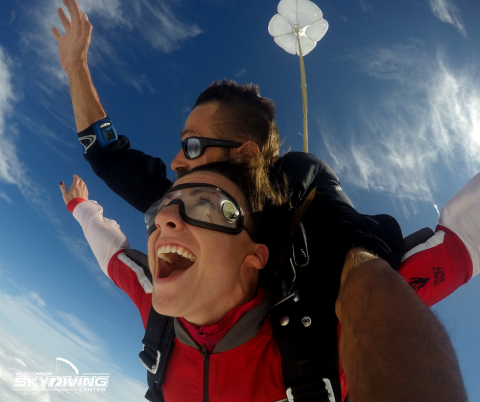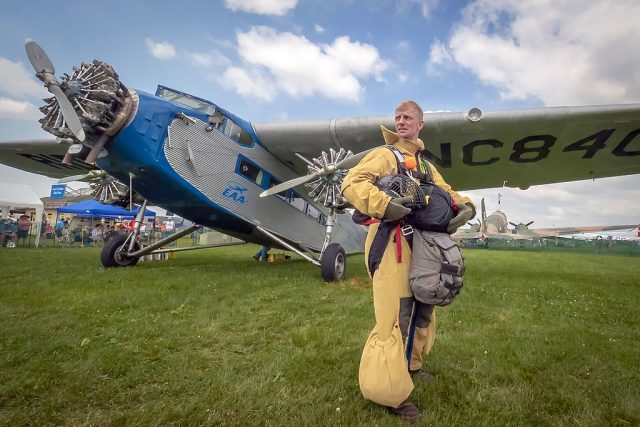Parachuting vs Skydiving
Skydiving Tips
Posted by: Wisconsin Skydiving Center 6 years ago
Parachuting vs skydiving – is it the same thing? What is parachuting, anyway?
Questions like these come up regularly here at the Wisconsin Skydiving Center. And — being the total nerds we are — we’re more than happy to launch in and split hairs. At its heart, after all, the skydiving and parachuting difference comes down to semantics. Which means that “parachuting vs. skydiving” is hardly a this-or-that at all.
But don’t worry — we’ll explain!
Skydiving Requires Parachuting
There’s an old joke in the sport of skydiving: You don’t need a parachute to skydive. You need a parachute to skydive twice.
It’s funny, of course, because it’s true. That’s the very good reason why the sport’s major organization in America is called the “United States Parachute Association,” not the “United States Skydiving Association.” But the USPA’s mission statement goes on to connect the two inextricably: “The United States Parachute Association [USPA] is a voluntary non-profit membership organization of individuals who enjoy and support the sport of skydiving.“

Parachuting doesn’t always require freefall; skydiving does
If there’s a definitional difference to point out here, it consists of the fact that it’s technically possible to make a parachute jump without much (if any) freefall.
When a person leaves an aircraft and immediately deploys a parachute, most people will categorize that jump as a skydive – but it’s definitely a parachute jump. If that parachute remains un-deployed for any time at all – like during freefall – the jump is definitely a skydive.
While the solo skydiving training method known as “static line” is rarely used in the modern sport of skydiving anymore, it used to be a common method of learning to skydive. The jumps made by static line students were often of the former style. The parachute of a static line skydiver is deployed by the act of that skydiver leaving the plane, essentially guaranteeing that his/her parachute will open immediately. (Note, however, that we still use the word “skydiver” to describe the jumper…).
These days, going “parachuting” almost always implies going to work
There’s another facet to the use of the word “parachuting” versus the use of the word “skydiving” to define a jump from a plane. It comes down to the purpose of the jump. These days, the word “parachuting” is most often used in the context of work, while “skydiving” is used in the context of play.
You’ll note this subtlety of language when professional freefall folks talk about what they do for a living. Smoke jumpers, SEALS and Special Forces operatives, for instance, “parachute.” Sport jumpers and international competitors “skydive.” (People who work in the skydiving industry, however — such as instructors and videographers — will pretty much always refer to their jumps as “skydives.”)

Why is this the case? Our guess is that this idiosyncrasy of English is owed to the fact that the act of parachuting only moved into the “fun” world from job-description status in the middle of the 20th century. How do we figure? Well: Take a peek at the dictionary. You’ll see that the word “skydiving” itself didn’t make its first appearance until the mid-1950s. “Parachuting”, however, made its debut almost 200 years beforehand.
Let’s go skydiving, then! And parachuting, too
The Wisconsin Skydiving Center is a big fan of both, naturally. On your tandem skydive, we’ll start you off with about a minute of sweet freefall. Your instructor then deploys a top-of-the-line parachute to complete your five-to-seven-minute descent back to your cheering friends and family in the landing area. And when they ask if you just went skydiving or parachuting, you’ll now be able to give them a significantly more complete response than they expected.
Nerdy high-fives, everyone!
Categories:
You May Be Interested In:

Can You Skydive With Dentures?
2 months ago by Wisconsin Skydiving Center

Why Is Skydiving So Expensive?
4 months ago by Wisconsin Skydiving Center

Can You Skydive In The Winter?
5 months ago by Wisconsin Skydiving Center

23 of the Best Skydiving Quotes and Captions for Social Media
12 months ago by Wisconsin Skydiving Center